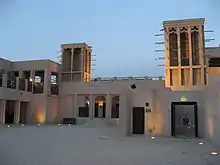Culture of the United Arab Emirates
The United Arab Emirates (UAE) has a diverse society.[1] The country's historical population as a small tribal community that has changed with the arrival of other nationals, in the mid-20th century.[2] The country was also part of the British Empire until 1971.[3]
Emirati culture is based on Arabian culture, with influences from the cultures of East Africa and Indian Subcontinent.[4] The religion of Islam has had a prominent influence on local architecture, music, attire, cuisine, and lifestyle. Five times every day, Muslims are called to prayer from the minarets of mosques, which are scattered around the country.[5] The weekend begins on Friday due to Friday being the holiest day for Muslims; most Muslim countries have a Friday-Saturday or Thursday-Friday weekend.[6]
The city of Al Ain in Abu Dhabi is a UNESCO World Heritage site.[7] The Emirate of Sharjah was named "The Cultural capital of the Arab World" by UNESCO in 1998 and the "Capital of Islamic Culture for 2014" by the OIC.[8]
Emirati people

Due to growth in trade, expatriates from over 200 nations have migrated to the UAE seeking better lives and higher-income jobs.[9]
The UAE has been criticized for perpetuating a class-based society, where migrant workers are in the lower classes.[10][11] Despite the diversity of the population, only minor and infrequent episodes of ethnic tensions, primarily between expatriates, have been reported.
Major holidays in Dubai include Eid ul-Fitr, which marks the end of Ramadan, and National Day (2 December), which marks the formation of the United Arab Emirates.[12]
The population as a whole is estimated by the U.S. State Department to be at 9 million people, with only 15–20% of these being citizens. The population growth rate is 4% per year. The primary religion in the United Arab Emirates is Islam, with the population estimated to be 96% Muslim. Hinduism and Christianity are minorities as stated by the United States State Department. The official language of the UAE is Arabic, although other languages such as English, Persian, Hindi and Urdu are also spoken. The U.S. State Department estimates the people of the UAE to have an average life expectancy of seventy-seven years.
Lexicology
The word Emirati is an English word derived from a combination of the word emir, which is an Islamic leader, and the English suffix -ate. It gradually came to mean the United Arab Emirates. The demonym Emirian has a similar root except with the suffix -ian being added to the emir. Rarer Emirian demonyms and adjectives include Emiri and Emiratian, both of which are unofficial and informal alternates.[13] However, due to strong tribal allegiances, many Emiratis also self-identify by their tribal affiliations, whereby some Emiratis may call themselves "Bani Yasi", "Suwaidi" or "al-Shamsi", especially if they come from an influential tribe. Historically, Emiratis were called Trucial Coasters[14] or Trucials in the medieval era.[15] In the ancient period, Emiratis were referred to as Maganites.[16]
Architecture

The United Arab Emirate's architecture is influenced by Islamic architecture and Arabian architecture.[17] For example, the "barjeel" has become an identifying mark of traditional Emirati architecture and is attributed to Persian influence.[4]
Emirati architecture reflects the traditional lifestyles and customs of the people. Building materials are simple, but well-adapted to local living and climate. For migrant tribes, portable tents traditionally provided shelter during the winter season. Inland, more permanent houses were built of stone guss with roofs made from palm tree leaves. Fossilized coral, cut in blocks, bonded with sarooj or a seashell-derived lime mixture, and plastered with chalk and water paste, was used extensively in coastal regions. Privacy and ventilation are important influences in the UAE.
Dress
Many older Emirati men prefer traditional Emirati clothes, such as the kandura, an ankle-length white shirt woven from wool or cotton. Many local women wear an abaya (black over-garment) and a headscarf.[18] On average, a UAE male national would have up to 50 kanduras to ensure cleanliness.[19] This attire is particularly well-suited to the UAE's hot, dry climate. Western-style clothing is also fairly popular, especially among the Emirati youth and expats. This is not always well received by local law enforcement: there have been several recent cases of expatriates being arrested for inappropriate attire or nudity.[20]
Traditional food
The Emirati diet is a mixture of a Bedouin diet (meat and camel milk), a fishermen's diet (fish), and a farmer's diet (dates). These foods, along with key spices such as cinnamon, saffron, and turmeric, form the basis of both historical and modern Emirati cuisine.[21] Vegetables that are easy to grow, such as cucumbers and tomatoes, are feature prominently in the diet. Dried lemons, called loomi, are grown locally and used in numerous dishes. Mangos are also grown in the northern emirates. Meats traditionally used include chicken or small fowl, such as Houbara bustards, and goats. Since camels are highly prized for milk and as a means of transportation, camel meat is normally reserved for special occasions.
Popular dishes include harees, fouga , kabsa and luqemat. Common middle eastern cuisine is also widely available. Due to the cosmopolitan nature of the United Arab Emirates, the most popular street-side snack is the Middle-Eastern shawarma.[22]
Greetings and social customs
For men, the traditional Emirati greeting is the khushmak, or touching of noses. The nose is seen as a noble body part in Emirati culture. Women greet each other by shaking hands and giving a kiss on the cheek.
Some expats accuse Emiratis of being standoffish towards foreigners, but Emiratis view this as a way to preserve their native culture.[23]
Literature and poetry
Themes in Emirati poetry are diverse, ranging from satire, self-praise, and patriotism, to chivalry, religion, family, and love.
As in many other Arab countries, poetry is considered a key art form. The style and form of ancient poetry in the UAE was strongly influenced by the 8th-century Arab scholar, Al Khalil bin Ahmed. This form underwent slight modification during the period of Islamic civilization in Andalucia, where "the line or bait adhered to the two hemistitches form, each with an equal number of feet, all the second hemistitches ending in the same rhyming letter and sound throughout the poem." Traditional forms persist today, although some Western styles of prose poetry have gained popularity.
Notable writers from the UAE during the 20th century, particularly for Classical Arabic poetry, include Mubarak Al Oqaili, Salem bin Ali al Owais, and Ahmed bin Sulayem. The Hirah group was an influential 20th-century trio of poets from Sharjah, and consisted of Khalfan Musabah, Sheikh Saqr Al Qasimi (an ex-ruler of Sharjah), and Sultan bin Ali al Owais. Their work was heavily influenced by western Romantic poets.[24] The first Emirati novel, Shahenda, was written by Rashid Abdullah Al Nuaimi.[25]
Contemporary literary figures include Nujoom Al-Ghanem, Ousha Al Sha'er, Khalid Albudoor, and Aisha Al Kaabi.
Music, dance, and film
The United Arab Emirates is a part of the Arab khaleeji tradition. Yowla is a type of music and dance performed mainly in communities of Bantu people from the African Great Lakes region.[24] Many traditional songs and dances, handed down from generation to generation, have survived to the present time. Young girls would dance by swinging their hair, which was traditionally worn long, and swaying their bodies. Men often re-enacted battles or successful hunting expeditions, often symbolically using sticks, swords, or rifles.
Hollywood and Bollywood movies are popular in Dubai.
The UAE has an active music scene, with international touring musicians such as Amr Diab, Diana Haddad, Tarkan, Aerosmith, Santana, Mark Knopfler, Elton John, Pink, Bon Jovi, Pink Floyd, Shakira, Celine Dion, Coldplay, Linkin Park, Zayn Malik, Slipknot, Tyga ,50 Cent and Phil Collins having performed in the country. The Abu Dhabi Festival has been held annually since 2004.
Sports

Football is the most popular sport in the UAE. Emirati football clubs Al-Ain, Al-Wasl, Al Nasr, Al-Sharjah, Al-Wahda, and Shabab Al-Ahli are the most popular teams and enjoy reputations as long-time regional champions.[26] The UAE national football team qualified for the FIFA World Cup in 1990 along with Egypt. It was the third consecutive World Cup with two Arab nations qualifying, after Kuwait and Algeria in 1982, and Iraq and Algeria again in 1986.[27] The UAE also won the Arabian Gulf Cup held in Abu Dhabi in January 2007.[28]
Cricket is one of the most popular sports in the UAE, largely due to the expatriate population from the Indian subcontinent. In the UAE there are 3 International Cricket stadiums in UAE. They have hosted many international cricket matches such as one T-20, 2014 IPL, and many more.
Brazilian Jiu-Jitsu is also increasing in popularity within the UAE. Both the adult team and the juvenile team frequently compete and win events both locally and internationally. The World Pro Abu Dhabi tournament attracts hundreds of competitors annually and features a large cash prize. Brazilian Jiu-Jitsu also features prominently in local Abu Dhabi school curricula.
Other popular sports include camel racing, car racing, falconry, endurance riding, and tennis.[29]
Magazines on Culture in the UAE
- The Vision (magazine) is a Dubai-based Magazine presenting Dubai's perspective on Culture, Art, Music, Business and Life in the Emirate.[30]
- Brownbook, based in Dubai, is an urban lifestyle guide focusing on art, design, and travel across the Middle East and North Africa.[31]
- Canvas is an international bi-monthly magazine dedicated to art and culture from the Middle East and Arab world.[32]
- Bidoun covers art and culture from the Middle East like paintings.[33]
Holidays
| Date | English | Arabic | |
|---|---|---|---|
| January 1 | New Year's Day | Ra's as-Sana al-meladiah | رأس السنة الميلادية |
| Zil Hajjah 10 | Day of the Sacrifice | Eid-ul-Adha | عيد الأضحى |
| Muharram 1 | Islamic New Year | Ra's as-Sana al-Hijria | رأس السنة الهجرية |
| Rajab 27 | The Night Journey | Al-Isra'a wal-Mi'raj | الإسراء والمعراج |
| December 2 | National Day | Yawm al watani | اليوم الوطني |
| Ramadan 29/30 Shawwal 1 | End of Ramadan | Eid-ul-Fitr | عيد الفطر |
See also
References
- "Country and Metropolitan Stats in Brief. MPI Data Hub
- "Negotiating Change: The New Politics of the Middle East". Jeremy Jones. 2007. pp. 184–186.
- "Sun sets on British Empire as UAE raises its flag".
- Folklore and Folklife in the United Arab Emirates. p. 167.
- "UAE Culture". Uae.gov.ae. 2000-06-01. Archived from the original on July 19, 2009. Retrieved 2009-07-15.
- Advanced Digital Technology www.adtworld.com. "New UAE Weekend". Gulfnews. Archived from the original on 2009-02-21. Retrieved 2009-07-15.
- Al Ain, a UNESCO World Heritage site.
- "Culture - The Official Portal of UAE Government". Retrieved 2016-06-30.
- Chaudhary, Suchitra (28 May 2016). "What makes UAE a role model of cohesion". GulfNews. Retrieved 14 November 2017.
- Gfs The Dark Side of Dubai, Johann Hari, The Independent, 7 April 2009.
- Batty, David (22 December 2013). "Campaigners criticise UAE for failing to tackle exploitation of migrant workers". The Guardian. Retrieved 11 November 2017.
- "Official holidays in UAE". Gowealthy.com. Archived from the original on 2009-02-08. Retrieved 2009-07-15.
- Douglas, Allen (1994). Arab comic strips. p. 150.
- Winder, Bayly (1965). Saudi Arabia in the Nineteenth Century. p. 33.
- Unexceptional: America's Empire in the Persian Gulf, 1941-2007, Marc J. O'Reilly, page 66
- Curtiss, Richard H. "The United Arab Emirates Today: Long UAE Archeological Record Shows Links to Earliest Civilizations." The Washington Report on Middle East Affairs 14.5 (1995): 56.
- Handbook of Islamic Marketing. p. 430.
Arabian inspired architecture is part of the expression of a local identity.
- "Clothing in the UAE". Grapeshisha.com. Archived from the original on 2009-03-31. Retrieved 2009-07-15.
- "UAE National Dress". yagulf.com.
- "Blame Europeans for topless displays, British women say". Gulfnews. Archived from the original on 2009-06-20. Retrieved 2009-07-15.
- Dubai Complete Residents' Guide. Explorer Publishing. 30 November 2006. p. 29. ISBN 9768182768.
- Jenny Walker; Terry Carter; Lara Dunston (2007). Oman, UAE & Arabian Peninsula. Lonely Planet. pp. 381–. ISBN 978-1-74104-546-8.
- Abed, Ibrahem (2001). United Arab Emirates: A New Perspective. p. 114.
- "Welcome to Abu Dhabi – Literature and Poetry". Visitabudhabi.ae. 2009-07-01. Archived from the original on March 21, 2009. Retrieved 2009-07-15.
- "Winners of Emirates Novel Award honoured". Retrieved 2018-11-28.
- "Clubs, Sports Clubs UAE United Arab Emirates". Indexuae.com. Archived from the original on 2009-07-17. Retrieved 2009-07-15.
- UAEinteract.com. "UAE – The Official Web Site – News". Uaeinteract.com. Archived from the original on 2017-06-16. Retrieved 2009-07-15.
- "Gulf Cup 2007". Gulfnews. Archived from the original on 2007-03-18. Retrieved 2009-07-15.
- "UAE Sports". Uae.gov.ae. Archived from the original on July 27, 2009. Retrieved 2009-07-15.
- "Vision Magazine".
- "Brownbook Magazine Homepage". Archived from the original on 29 March 2018. Retrieved 24 May 2010.
- "Canvas Online". Retrieved 24 May 2010.
-
- Bidoun Archived 2010-05-24 at the Wayback Machine